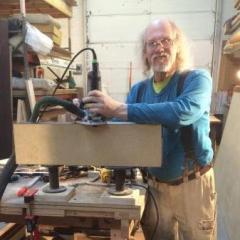-
Posts
2,255 -
Joined
-
Last visited
About AceHoleInOne
- Birthday 07/27/1960
Profile Information
-
Gender
Male
-
Location
Detroit, Michigan
-
Woodworking Interests
Refinishing furniture. Getting into Fine Woodworking, built some clocks, small chests, tables and now working on a lowboy.
Years ago worked bump and paint with my brother.
Recent Profile Visitors
5,656 profile views
AceHoleInOne's Achievements

Master Poster (3/3)
508
Reputation
-
I'm gonna assume your wood working interest have shifted and other priorities in life are forefront? So not as much time in the shop? If so -- and your stuff been sitting around gathering dust ... make a change. It is what it is!!!! -Ace-
-
You don't have to do the door panel separate. I will get the stain a little wetter around where the door panel and the cope and stick meet. Then use compressed air to blow the stain under. Also, the compressed air will feather the color better in corners, unlike using a brush or rag. -Ace-
-
Glue introduces moisture to the joint, causing swell. Should you sand while wood hasn't fully recovered or cured, shrunk back. Basically you sand off the high spot. As the glue shrinks and cures... you now have an ever so slight depression. When you apply a slow drying finish as in this case, the wood re-wets swells and the finish hardens in the swelled wood causing an issue. Sometimes, I find the cause can be a glue starved joint and the finish works down and can swell the joint. I think in this particular case, it was all the process that may of caused the issue ...water/lye/ finish/sand off/water/lye/finish. The wood was subjected to many cycles of moisture and perhaps compromised the outer portion of a couple glue seams. That's my 2 cents -Ace-
-
Awesome work...only if there is a way to keep the red coloring...mine all faded away after several years. -Ace-
-
Hope this helps you understand what were going for. -Ace-
-
That is correct. You don't need to curve the blade and whatever you do...don't slice. Its a gentle take your time task. Don't try this until the finish is cured. -Ace-
-
Hold on....I read further down...you used lye on the wood? Did you neutralize the lye before top-coating??????? -Ace-
-
Any finish can blush. My guess the reason the other parts didn't blush was due to the finish being applied thinner...meaning those coats weren't as thick. Being a counter top the finish was applied flat laying down so applied a little thicker, so the finish was still wet and curing. Give it time and see if it clears up. -Ace-
-
Take a razor blade...apply clear tape to either end of the blade to lift the blade off the surface to prevent scratching the surface around the drop. Use the center of the blade to gently scrape and level the drop. Think of it as a small card scraper. -Ace-
-
Reach out to General Finishes. The thing to remember using pigmented topcoats, when they chip or get damaged... you remove color and can metal mark on light colors. Perhaps keep the paint approach for ease of custom colors and simply apply a topcoat over the wood paint to achieve better durability. Most of the water-based paints formulated for wood are pretty damn tough and don't need top coating. However, I would stick with one finish manufacture for paint and topcoat to make certain they play nice with each other. Professional tinted topcoats are more geared for production. Some tinted products can't take too much tinting by volume, so the color range could be limited? -Ace-
-
I have the Mirka Ceros, expensive but worth every cent. I have no dust to worry about and sand without a mask (that's just me so don't hate). Over the years, I have gone through so many cheap sanders, its not funny. Really makes the process more enjoyable. I have plenty of power to run 60 grit all day long if need be. Ceros has different speed settings to handle any sanding need. I have the 5" pad and only once...wished I had the 6" for sanding a bunch of flat hallway doors. Other than that a 5" disk is fine, plus the abrasives are cheaper for a 5" disk. If you're remotely thinking going better...do it. Only hurts once and cheap out on another shop machine to keep in budget. You'll be glad you did, trust me. I work from a basement workshop and dust is always my concern and money well spent. -Ace-
-

Danish oil, how long before you can apply laquer
AceHoleInOne replied to johneone's topic in Finishing
Figured wood drinks in the oil due to the grain and will take longer to gas off. Longer the better. Wait as long as possible, 10 days or longer would be my advice, but not sure how many coats you applied, your climate...etc. -Ace- -
If this were me. I would use and outdoor topcoat. Something that is easily renewable. The best thing you can do is devise some sort of tarp covering while not in use to keep dirt/sun and the elements off while not in use. In the wintertime, think about shrink wrapping (like they do to boats) the entire Bar top while it sleeps in winter. This would be the best way to keep it new looking for as long as possible. -Ace-
-
It all depends, 320 could of worked. 220 could work. Hand sand can work so can machine sand. Picture? -Ace-
-
I can understand why it wont dry over butcher block conditioner its mineral oil yes? As we know, mineral oil takes forever to dry and I wouldn't use it over top of that. I would not use a gel topcoat because you have to work that a little more and could remove color. I would brush or spray a topcoat and not over work it. Get the finish on as fast as possible and let it dry. The goal is to seal it down, then build a finish. -Ace-









